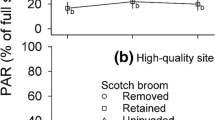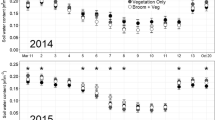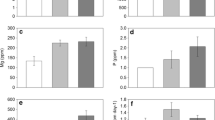Abstract
Backgrounds and aims
Scotch broom is an N-fixing invasive species that has high potential to alter soil properties. We compared soil from areas of Scotch broom invasion with nearby areas that had no evidence of invasion to assess the influence of broom on soil P fractions and other chemical properties.
Methods
The study was conducted at two contrasting Douglas-fir sites in Oregon (OR) and Washington (WA), USA with broom invasion for 10 years. We used the Hedley sequential fractionation procedure to assess effects of Scotch broom invasion on P pools of varying bioavailability, and also measured total C, N and extractable nutrient cations.
Results
Total soil C and N were significantly higher with broom present at the fine-textured OR site, but there was no effect at the coarse-textured WA site. There was no difference in labile-P measures between the presence and absence of Scotch broom at either site, but there were notable reductions (25–30 %) in the intermediately-available P fraction when broom was present. Extractable nutrient cations (notably K) were lower in the presence of broom at both sites, with the effects most pronounced at the fine-textured OR site.
Conclusions
Lasting effects of Scotch broom invasion are likely to be associated with variable changes in soil C, N, and decreases in extractable nutrients and available P. These changes, and other documented effects of Scotch broom on soil, are likely to have lasting effects on Douglas-fir growth after Scotch broom removal that will vary depending soil nutrient status at a given site.

Similar content being viewed by others
References
Adams MB, Angradi TT, Kochenderfer IN (1997) Stream water and soil solution responses to 5 years of nitrogen and sulfur additions at the fernow experimental forest, West Virginia. For Ecol Manag 95:79–91
Ballard TM and Carter RE (1986) Evaluating forest stand nutrient status. Land management report No. 20. British Columbia Ministry of Forests, Victoria, Canada
Binkley D (2005) How nitrogen fixing trees change soil carbon. In: Binkley D, Menyailo O (eds) Tree species effects on soils: implications for global change, NATO science series. Kluwer Academic Publishers, Dordrecht
Blaser WJ, Sitters J, Hart SP, Edwards PJ, Venterlink HO (2013) Facilitative or competitive effects of woody plants on understorey vegetation depend on N-fixation, canopy shape, and rainfall. J Ecol 101:1598–1603
Bossard CC (1993) Seed germination in the exotic shrub cytisus scoparius (scotch broom) in California. Madrono 40:47–61
Bossard CC, Rejmánek M (1994) Herbivory, growth, seed production, and resprouting of an exotic invasive shrub, Cytisus scoparius. Biol Conserv 67:193–200
Brady NC, Weil RR (2008) Chapter 9: the colloidal fraction. In: Brady NC, Weil RR (eds) The nature and properties of soils, 14th edn. Pearson-Prentice Hall, Upper Saddle River, NJ
Caldwell BA (2006) Effects of invasive scotch broom on soil properties in a pacific coastal prairie soil. Appl Soil Ecol 32:149–152
Chen CR, Sinaj S, Condron LM, Frossard E, Sherlock RR, Davis MR (2003) Characterization of phosphorus availability in selected New Zealand grassland soils. Nutr Cycl Agroecosyst 65:89–100
Cochran WG, Cox GM (1950) Experimental designs. John Wiley and Sons, New York, NY, 454 pp
Compton JE, Cole DW (1998) Phosphorus cycling and soil P fractions in Douglas-fir and red alder stands. For Ecol Manag 110:101–112
Condron LM, Newman S (2011) Revisiting the fundamentals of phosphorus fractionation of sediments and soils. J Soils Sediments 11:830–840
Cross AF, Schlesinger WH (1995) A literature review and evaluation of the Hedley fractionation: applications to the biogeochemical cycle of soil phosphorus in natural ecosystems. Geoderma 64:197–214
DeBruler DG (2014) Soil carbon, nutrients, and phosphorus fractions: responses to weed control and harvest residual retention in two 10-year-old Douglas-fir (Pseudotsuga menziesii) stands of the Pacific Northwest. M.Sc. Thesis. Virginia Polytechnic Institute and State University, Blacksburg, Virginia
Devine WD, Harrington TB, Terry TA, Harrison RB, Slesak RA, Peter DH, Harrington CA, Shilling CJ, Schoenholtz SH (2011) Five-year vegetation control effects on aboveground biomass and nitrogen content and allocation in Douglas-fir plantations on three contrasting sites. For Ecol Manag 262:2187–2198
Ehrenfeld JG (2003) Effects of exotic plant invasions on soil nutrient cycling processes. Ecosystems 6:503–523
Fogarty G, Facelli JM (1999) Growth and competition of cytisus scoparius, an invasive shrub, and Australian native shrubs. Plant Ecol 144:27–35
Giardina CP, Huffman S, Binkley D, Caldwell B (1995) Alders increase soil phosphorus availability in a Douglas-fir plantation. Can J For Res 25:1652–1657
Grotkopp E, Rejmánek M (2007) High seedling relative growth rate and specific leaf area are traits of invasive species: phylogenetically independent contrasts of woody angiosperms. Amer J Bot 94(4):526–532
Grove S, Haubensak KA, Parker IM (2012) Direct and indirect effects of allelopathy in the soil legacy of an exotic plant invasion. Plant Ecol 213:1869–1882
Halverson NM, Topik C and Van Vickle R (1986) Plant association and management guide for the western hemlock zone. Mount hood national forest. USDA forest service, Pacific Northwest Region, Portland, OR. R6-ECOL-232A-1986. pp. 62–65
Harrington TB, Schoenholtz SH (2010) Effects of logging debris treatments on 5 years development of competing vegetation and planted Douglas-fir. Can J For Res 40:500–510
Harrington TB, Slesak RA, Schoenholtz SH (2013) Variation in logging debris cover influences competitor abundance, resource availability, and early growth of planted Douglas-fir. For Ecol Manag 296:41–52
Haubensak KA, Parker IM (2004) Soil changes accompanying invasion of the exotic shrub cytisus scoparius in glacial outwash prairies of western Washington [USA]. Plant Ecol 175:71–79
Hedley MJ, Stewart JWB, Chauhan B (1982) Changes in inorganic and organic soil phosphorus fractions induced by cultivation practices and by laboratory incubations. Soil Sci Soc Am J 46(5):970–976
Henderson JA, Peter DH, Lesher RD and Shaw DC (1989) Forested plant associations of the Olympic national forest. USDA Forest Service Report No. R6-ECOL-TP 001–88. pp. 350–353
Houlton BZ, Wang Y, Vitousek PM, Field CB (2008) A unifying framework for dinitrogen fixation in the terrestrial biosphere. Nature 454:327–330
Powers RF, Alban DH, Miller RE, Tiarks AE, Wells CG, Avers PE, Cline RG, Fitzgerald RO, Loftus NS Jr. (1990) Sustaining site productivity in North American forests: problems and prospects. In: Gessel SP et al. (eds) In Sustained productivity of forest soils. Forestry Publications, University of British Columbia, Vancouver, p. 49–80
PRISM Climate Group (2012) PRISM (Parameter-elevation Regressions on Independent Slopes Model) climate mapping system. Oregon State University. http://prism.oregonstate.edu
SAS Institute Inc (2013) The SAS system for windows, version 9.4. Cary, North Carolina
Lambert MG, Jung GA, Harpster HW, Lee J (1989) Forage shrubs in north island hill country 4. Chemical composition and conclusions. N Z J Agric Res 32:499–506
Mika PG, Moore JA (1990) Foliar potassium status explains Douglas-fir response to nitrogen fertilization in the inland northwest, USA. Water Air Soil Pollut 54:477–491
Richter DD, Allen HL, Li J, Markewitz D, Raikes J (2006) Bioavailability of slowly cycling soil phosphorus: major restructuring of soil P fractions over four decades in an aggrading forest. Ecosyst Ecol. doi:10.1007/s00442-006-0510-4
Shaben J, Myers JH (2009) Relationships between scotch broom (cytisus scoparius), soil nutrients, and plant diversity in the Garry oak savannah ecosystem. Plant Ecol. doi:10.1007/s11258-009-9655-7
Sitters J, Edwards PJ, Venterink HO (2013) Increases of soil C, N, and P pools along an acacia tree density gradient and their effects on trees and grasses. Ecosystems 16:347–357
Smethurst PJ, Herbert AM, Ballard LM (2001) Fertilization effects on soil solution chemistry in three eucalypt plantations. Soil Sci Soc Am J 65:795–804
Smith JMB (2000) An introduction to the biogeography and ecology of broom (cytisus scoparius) in Australia. p. 140–144 in Sheppard AW and Hosking JR, broom management, process of a workshop, ellerston and moonan, Australia, Nov. 16–17, 1998. Plant Prot Q 15(4):134–186
Van Miegroet H, Cole DW (1984) The impact of nitrification on soil acidification and cation leaching in a red alder ecosystem. J Environ Qual 13:586–590
Vitousek PM, Horwath RW (1991) Nitrogen limitation on land and in the sea: how can it occur? Biogeochemistry 13(2):87–115
Vitousek PM, Porder S, Houlton B, Chadwick O (2010) Terrestrial phosphorus limitation: mechanisms, implications, and nitrogen-phosphorus interactions. Ecol Appl 20:5–15
Walker TW, Syers JK (1976) The fate of phosphorus during pedogenesis. Geoderma 15:1–19
Watt MS, Whitehead D, Mason EG, Richardson B, Kimberly MO (2003) The influence of weed competition for light and water on growth and dry matter partitioning of young Pinus radiata, at a dryland site. For Ecol Manag 183:363–376
Wearne LJ, Morgan JW (2004) Community-level changes in Australian subalpine vegetation following invasion by the non-native shrub cytisus scoparius. J Veg Sci 15:595–604
Weidenhamer JD, Callaway RM (2010) Direct and indirect effects of invasive plants on soil chemistry and ecosystem function. J Chem Ecol 36:59–69
Wheeler CT, Helgerson OT, Perry DA, Gordon JC (1987) Nitrogen fixation and biomass accumulation in plant communities dominated by cytisus scoparius L. in Oregon and Scotland. J Appl Ecol 24:231–237
Wink M, Twardowski T (1992) Allelochemical properties of alkaloids: effects on plants, bacteria and protein biosynthesis. In: Rizvi SJH, Rizvi V (eds) Allelopathy: basic and applied aspects. Chapman and Hall, New York, USA
Acknowledgments
This work was funded by the USDA Agriculture and Food Research Initiative-Controlling Weedy and Invasive Plants program, the USDA Forest Service-Pacific Northwest Research Station, and the University of Minnesota. We are grateful to Randall Greggs of Green Diamond Resource Company and Mike Warjone of Port Blakely Tree Farms LLC for logistical support and access to the study sites. Special thanks are given to James Dollins and Dave Peter for assisting with field sampling and study establishment, and to Stephen Schoenholtz and Daniel DeBruler for conducting the laboratory analyses.
Author information
Authors and Affiliations
Corresponding author
Additional information
Responsible Editor: Hans Lambers.
Rights and permissions
About this article
Cite this article
Slesak, R.A., Harrington, T.B. & D’Amato, A.W. Invasive scotch broom alters soil chemical properties in Douglas-fir forests of the Pacific Northwest, USA. Plant Soil 398, 281–289 (2016). https://doi.org/10.1007/s11104-015-2662-7
Received:
Accepted:
Published:
Issue Date:
DOI: https://doi.org/10.1007/s11104-015-2662-7




